Understanding Kiteboard Foot Straps: A Guide
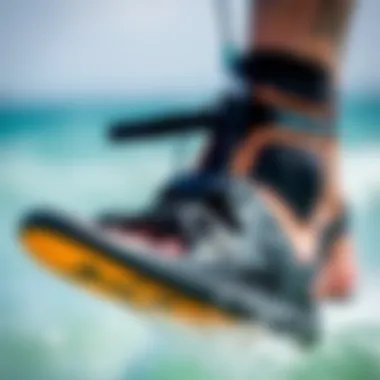
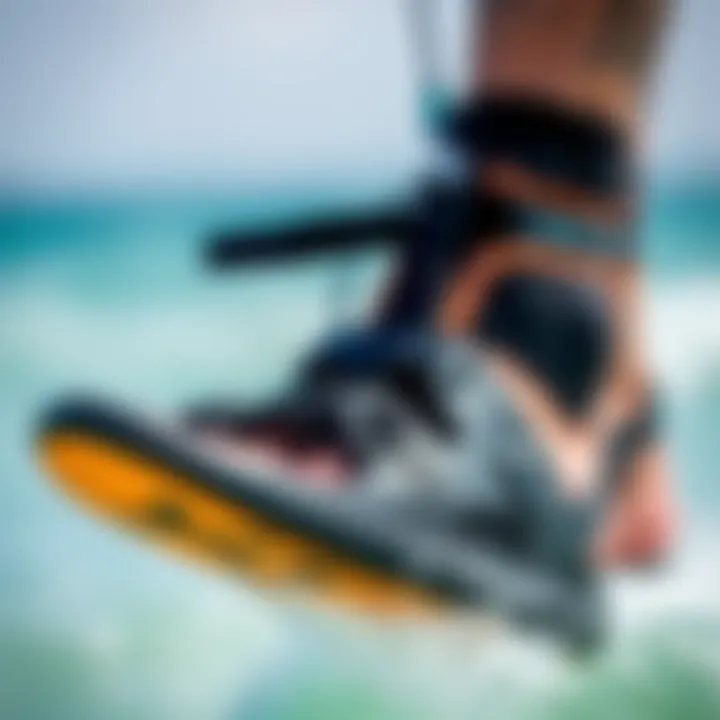
Intro
Kiteboarding is not just about the thrill of riding the waves; it's about the connection between you and your equipment. One of the key components that can make or break your riding experience are foot straps. Whether you’re just starting or have been carving up the ocean for years, understanding these straps is vital.
Foot straps play a pivotal role in ensuring that your feet stay attached to the board while managing the high-speed, dynamic conditions experienced in kiteboarding. Good fit and functionality provide confidence, allowing you to focus on the ride instead of fretting about losing your footing.
This guide seeks to unpack the significance of foot straps, evaluating various designs and how they fundamentally affect your experience on the water. Additionally, we’ll delve into how to select the perfect pair for your style and the different maintenance techniques that will keep them in optimal shape.
As we move forward, expect to find insights into the equipment and techniques that will enrich your kiteboarding experience. Whether you're looking at the latest gear reviews or aiming to master your maneuvers, this guide aims to offer something for everyone palying around the waves.
Intro to Kiteboard Foot Straps
Kiteboarding is an exhilarating sport that merges the elements of surfing, paragliding, and windsurfing. At the heart of this thrilling experience lies an oft-overlooked component — the foot straps. Understanding these straps is not just important; it’s essential for any kiteboarder who wants to maximize performance and enjoyment on the water.
Foot straps are crucial in securing the rider’s feet to the board while providing stability, control, and the ability to perform various maneuvers. When properly fitted and selected, they can greatly influence the overall kiteboarding experience, allowing for fluid transitions, enhanced carving, and even some airborne tricks. But these straps are not a one-size-fits-all solution; they come with a variety of designs and features tailored to different styles of riding.
Significance in Kiteboarding Performance
Foot straps can make or break your kiteboarding performance. If they are too loose, you run the risk of losing your balance or even your board entirely. On the flip side, if they are too tight, it could lead to discomfort or even injury. Thus, striking the right balance is key.
An important aspect to consider is how foot straps can affect the rider's ability to steer, jump, and land smoothly. Properly adjusted foot straps help distribute weight evenly, reducing the strain on legs and back while allowing more precise control over the kite. A well-chosen strap can also cater to the specific demands of tricks and jumps, giving the rider confidence to push boundaries.
Moreover, the importance of foot straps extends beyond performance. Comfort during long rides and the efficiency of energy transfer from the kite to the board can enhance not only enjoyment but also endurance. Ultimately, foot straps are the bridge that connects the rider to the water, making their understanding indispensable for both new enthusiasts and seasoned professionals alike.
Overview of Foot Strap Variants
When diving into the world of foot straps, it’s essential to recognize the variety available. Each variant caters to different needs and riding styles, making it crucial to pick a suitable type based on the rider's preferences and the conditions they typically encounter.
Foot Strap Variants Include:
- Standard Straps: Basic, straightforward designs that are effective for general use.
- Adjustable Straps: Feature mechanisms allow for quick adjustments, accommodating different shoe sizes or preferences.
- Foam-Padded Straps: Provide added comfort with extra cushioning for those long hours on the water.
- Neoprene Straps: Known for their flexibility and lightweight characteristics, making them ideal for dynamic riding styles.
- Multi-Purpose Straps: Versatile options designed for a blend of different riding styles.
- Specialized Foot Straps: Tailored for specific disciplines, such as freestyle or wave riding, to optimize performance in those areas.
By understanding these variants, kiteboarders can make informed decisions about the foot straps that best align with their individual riding styles, contributing to a more enjoyable and effective kiteboarding experience.
"Selecting the right foot strap is as crucial as choosing the right kite; it dramatically influences how you connect with the water and the wind.”
The journey to finding the perfect foot strap is one that can lead to enhanced performance and a more enjoyable ride—one not to be overlooked.
Types of Kiteboard Foot Straps
In the world of kiteboarding, choosing the right foot strap can greatly influence comfort and performance on the water. Foot straps not only play a pivotal role in securing the rider to the board, but they also affect riding style, stability, and overall enjoyment of the sport. The variety of foot straps available today reflects advancements in kiteboarding technology and the evolving needs of riders.
Whether you are a novice catching your first waves or an expert executing complex maneuvers, understanding the different types of foot straps will help you make an informed decision that enhances your kiteboarding experience.
Standard vs. Adjustable Foot Straps
Standard foot straps are designed with a fixed length, making them suitable for riders who prefer consistent fitting. They may lack flexibility for adjustments, but they provide a sense of security, which some riders find beneficial, especially in less challenging conditions. On the contrary, adjustable foot straps allow users to customize the fit according to their preferences.
- Advantages of Standard Foot Straps:
- Benefits of Adjustable Foot Straps:
- Simple design, often lighter
- Reliable for consistent performance
- Offers adaptability for varying foot sizes
- Enables on-the-fly adjustments depending on riding conditions
When deciding between standard and adjustable strapping, consider how much versatility you want. If you're just starting out and sticking mostly to calm waters, standard straps may suffice. However, for those who often face changing conditions or prefer to load the board differently, adjustable straps could be the way to go.
Foam-Padded vs. Neoprene Straps
Foam-padded straps stand out for their additional comfort and shock absorption capabilities. They tend to cushion the foot, providing longer-lasting comfort during extended rides. Alternatively, neoprene straps are known for their durability and weather resistance, making them an appealing choice for those who take their kiteboarding into harsher environments.
- Pros of Foam-Padded Straps:
- Pros of Neoprene Straps:
- Enhanced comfort over long periods
- Good at absorbing impacts and providing protection
- Highly resistant to wear and tear
- Typically lighter and water-repellent
The choice between foam-padded and neoprene straps hinges on personal preference. If comfort is your utmost concern, lean towards foam-padded options. However, for rigorous environments and heavy use, neoprene might hold up better in the long run.
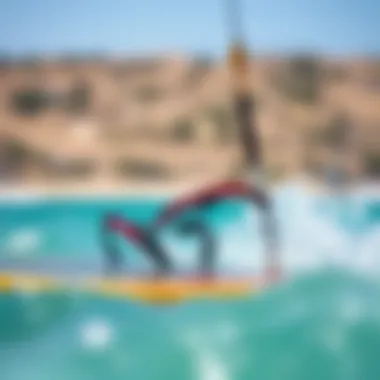
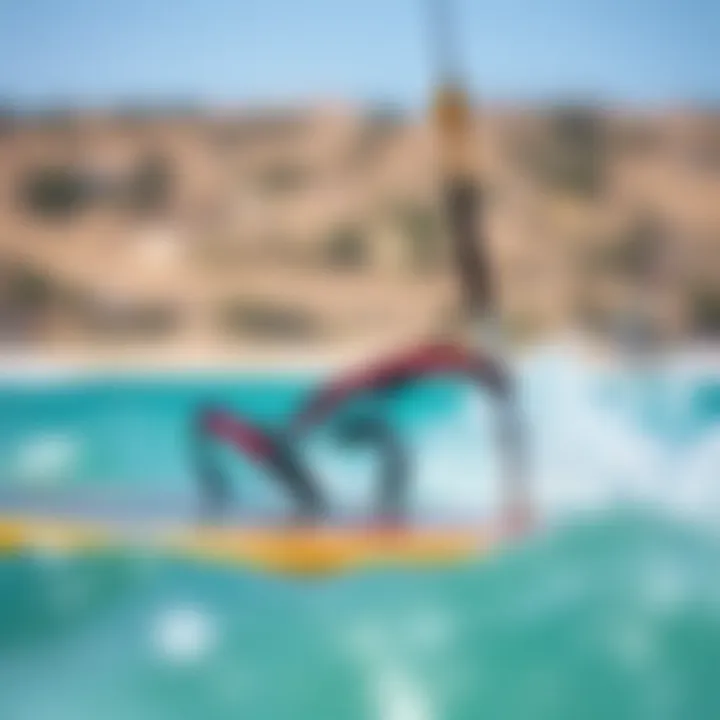
Multi-Purpose vs. Specialized Foot Straps
When diving into the realm of multi-purpose versus specialized foot straps, one must recognize that each type serves distinct purposes tailored to the rider's style or preferences. Multi-purpose foot straps offer versatility—great for kiteboarders who enjoy dabbling in various styles, from freestyle to wave riding. These straps cater to an all-around riding experience, making them a favored choice among many.
Conversely, specialized straps are crafted for specific styles or conditions. For example, some may feature designs tailored for strapless riding or for optimizing performance in tricks.
- Multi-Purpose Foot Straps:
- Specialized Foot Straps:
- Good for various riding styles
- Can be used in diverse environmental conditions
- Engineered for specific disciplines (e.g., freestyle, wave)
- May provide added features like extra grip or rigidity
In essence, if you find joy in mixing things up on the water, go for multi-purpose straps. However, serious competitors or dedicated style riders should consider investing in specialized straps that complement their techniques.
"Choosing the right strap comes down to how you enjoy riding and what fits within your kiteboarding lifestyle."
Ultimately, understanding the diversity within foot straps is essential for any kiteboarder. Taking the time to weigh the differences can lead to improvements in comfort, performance, and enjoyment on the waves.
Design Features of Foot Straps
When it comes to kiteboarding, foot straps play a pivotal role. At first glance, they might seem like simple pieces of equipment, but their design is crucial for performance, comfort, and safety on the water. Understanding the specific features of foot straps can help you choose the right ones that suit your needs, enhancing your overall kiteboarding experience.
Material Considerations
The material of foot straps can significantly affect both their durability and comfort. Common materials include neoprene and various forms of high-density foam. Neoprene offers flexibility and is resistant to water, allowing it to maintain its integrity even when wet. This is a key feature for kiteboarders who spend long days on the water.
On the other hand, foam-padded straps provide a bit more cushioning, which can be very helpful when landing jumps or enduring long rides. However, not all foam is created equal. A high-density foam may keep its shape better over time compared to a low-density foam that can compress quickly.
Each material type has its pros and cons, making it vital to consider your personal preferences and riding style when selecting. For example:
- Neoprene: Offers excellent moisture resistance and flexibility.
- Foam Padding: Provides additional comfort but could wear down more rapidly than neoprene.
A strap made of a material that suits your riding conditions can make all the difference between a great session and a painful one.
Size and Shape Dynamics
Another essential consideration in foot strap design is size and shape. Foot straps come in various widths, lengths, and shapes, catering to different foot sizes and styles of riding.
- Width: Wider straps generally distribute the load more evenly across your feet, reducing pressure points and enhancing comfort. Ideal for freestyle riders, wider straps can help to keep you more connected to the board.
- Length: Adjustable straps enable the user to find the perfect fit, keeping the foot secure without being overly tight. It's essential that the strap fits snugly; a loose strap could lead to a lack of control.
- Shape: Curved straps offer a more ergonomic fit, cradling the foot better, while flat designs may suit others who prefer more of a traditional feel. Riders with larger feet or specific foot shapes may find differently shaped straps quite beneficial.
Finding the right size and shape is crucial, as it impacts how you transition, jump, and maneuver on the water.
Buckles and Fastening Systems
The fastening system of a foot strap can make or break your experience on the water. Included in various designs are different kinds of buckles and fastening mechanisms.
- Classic Buckle Systems: These are often simple and intuitive, allowing for quick adjustments even while on the water. They can sometimes be prone to loosening if not tightened properly.
- Velcro Straps: Velcro systems have gained popularity for their ease of use. They allow for precise adjustments and can retain their grip well under normal kiteboarding conditions. Plus, they are often lighter than traditional buckle systems.
- Quick-Release Mechanisms: Some advanced systems include quick-release mechanisms for safety, allowing riders to detach from the board rapidly during emergencies. While typically found on professional-level straps, they offer peace of mind in some tricky situations.
Selecting the right buckle type ensures that you can focus more on your riding and less on your equipment securing correctly.
Choosing the Right Foot Strap
Choosing the right foot strap for your kiteboard is like finding the right pair of shoes for a long hike; it can either make or break your experience on the water. The foot straps serve as the primary connection between you and your board, impacting not only comfort but also performance and control. A well-fitted and suitable foot strap allows for better maneuverability and reduces the risk of injuries.
Selecting the right strap involves considering various factors that cater to your personal preferences and riding style. In this section, we will break down what to look for when choosing foot straps, ensuring you make the right choice to enhance your kiteboarding adventures.
Factors Influencing Selection
When it comes to selecting foot straps, factors such as material, size, and adjustability play a pivotal role. These elements can significantly influence your riding comfort and technique. Here’s what to ponder when shopping through the sea of options:
- Material: Different materials, like neoprene or foam, offer various levels of comfort and support. Neoprene tends to be more durable and weather-resistant, while foam may provide better cushioning.
- Size and Fit: The size of the strap must be compatible with the shape and size of your feet. A snug fit can prevent unwanted movement, allowing for greater control during maneuvers.
- Adjustability: Look for straps that offer adjustable features. This becomes essential for accommodating different shoe sizes or personal preferences, making them suitable for both beginners and seasoned kiteboarders.
Choosing the right foot strap can significantly enhance your control on the water, allowing for quicker turns and smoother rides.
Personal Riding Style Considerations
Your personal riding style greatly influences the type of foot strap that’s suited for you. Are you the type who enjoys cruise control, savouring the scenic views, or are you a thrill-seeker pushing the limits for adrenaline? Identifying your riding style will narrow down your options effectively.
- Freestyle Riders: If you dabble in freestyle, opt for straps that allow for easy entry and exit. This means looking for soft yet secure options that provide max grip without restriction.
- Wave Riders: Those who take on waves should prioritize straps with excellent support and a secure fit, as they need to maintain tight control during rapid and dynamic movements.
- Beginner Kiteboarders: If you’re just starting, it’s wise to invest in adjustable foot straps. They can grow with you as you progress. Comfort is also key, so look for padded options that don’t compromise your ride.
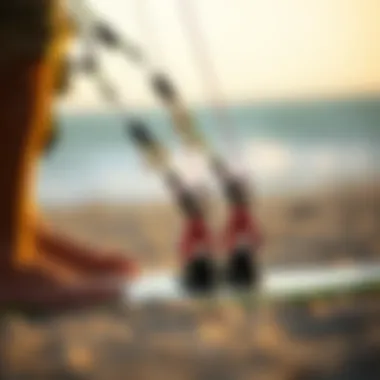
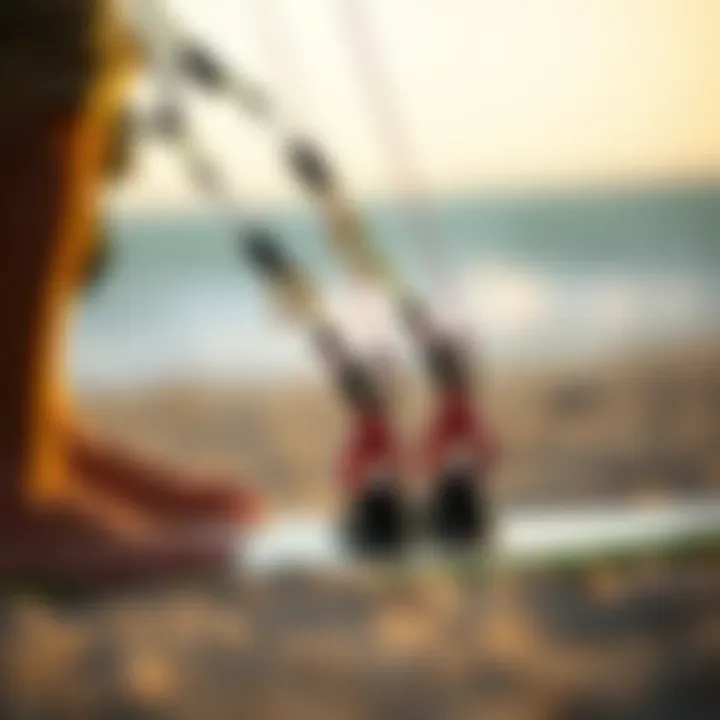
Finding the correct foot strap comes down to understanding both the technical aspects and the personal style that makes your experience unique. It’s worth spending time to test options, ensuring that each strap fits like a glove and enhances your overall kiteboarding journey.
Foot Strap Installation Techniques
Proper installation of foot straps is a cornerstone of an enjoyable kiteboarding experience. The way these straps fit on the board can significantly influence performance, rider comfort, and, ultimately, safety. A well-installed foot strap allows for better control, stability, and can actually enhance your ability to perform tricks. On the flip side, improper installation can lead to discomfort and even injuries. Therefore, understanding the right techniques to set up your foot straps is crucial for both beginners and seasoned kiteboarders alike.
Preparing the Board and Straps
Before diving headfirst into installation, taking time to prepare both the board and the straps can save a boatload of headaches later. This preparatory phase is more than a simple warm-up; it sets the stage for success.
- Inspect the Board: Look over your kiteboard closely. Ensure there’s no debris in the foot strap holes and that the screws thread smoothly. Clean off any sand or residue to avoid problems while installing.
- Choose the Right Straps: Make sure the foot straps you have match the style of your board and riding technique. There’s nothing worse than trying to fit a square peg into a round hole.
- Adjust the Straps: If your foot straps are adjustable, experiment with settings before installation. It might help to place them near the width you think is best based on your foot size and riding style. This preemptive adjustment helps in speeding up the final setup.
Preparing well ensures that you’re not fumbling at the crucial moment when it’s time to hit the water.
Steps for Proper Installation
Getting the installation right can feel like piecing together a jigsaw puzzle. Follow these steps methodically to achieve a secure and effective setup:
- Align the Straps: Position the straps horizontally across the pads of the board. Make sure they're evenly placed to support each foot.
- Feed the Screws: Pass the screws through the strap holes, aligning them properly. To avoid cross-threading, it’s essential to keep them straight and use minimal force initially.
- Tighten just Right: Use a screwdriver to tighten the screws, but be cautious not to overtighten them. Straps need to be secure yet flexible enough to allow for movement.
- Check Positioning: Stand on the board with the straps to ensure they feel comfortable. Adjust accordingly if they feel too tight or loose.
- Secure Everything: Once you feel satisfied, do a final check on all screw placements to ensure nothing has loosened.
By following these steps, you’ll set yourself up for success on the water, reducing chances of any unpleasant surprises!
Testing Foot Strap Security
After completing the installation, it’s imperative to ensure everything is locked down tight. Testing security goes beyond a mere visual inspection; it requires an authentic check of how stable your straps are under pressure. Here’s how:
- Physical Test: Stand on the board while it’s resting on a flat surface, shifting your weight around. If the straps budge, adjust them immediately.
- Wiggle and Pull: Test the straps by tugging and wiggling them gently. A secure strap shouldn’t budge or feel loose during this test.
- Perform Movement Drills: Practice some basic movements or transitions while still on dry land. Any odd feelings or shifts in strap positioning can indicate a poorly installed strap.
Remember: Precaution is better than cure. If you’re ever in doubt about your strap’s security, double-check or consult with a more experienced kiteboarder.
In summary, following these installation techniques ensures you maximize your kiteboarding performance. A set-up that is secure and tailored to your riding style leads to a more thrilling and safe ride.
Maintenance of Foot Straps
In kiteboarding, foot straps play a pivotal role in how you connect with the board and the water beneath your feet. Just like maintaining a well-tuned engine in a car, keeping your foot straps in good shape is essential for maximizing your performance and ensuring your safety on the water. Proper maintenance not only enhances your riding experience but also prolongs the lifespan of your gear. Regular upkeep can prevent mishaps caused by faulty equipment, making your sessions smoother and more enjoyable.
Cleaning Guidelines
Cleansing your foot straps after each ride may seem trivial, but this step can make all the difference. Saltwater, sand, and dirt accumulate over time, leading to wear and tear. To clean them effectively:
- Fresh Water Rinse: After every session, rinse your straps with fresh water to wash away any salt, sand, or debris.
- Mild Soapy Solution: Use a soft cloth or sponge dipped in a mild soapy solution to scrub the straps gently. Harsh chemicals may degrade the material, so stick to gentle cleansers.
- Drying: Always air dry your straps in a cool, shaded area. Avoid direct sunlight as it can weaken the material and lead to cracking.
These simple steps help keep your foot straps looking sharp while maintaining their structural integrity.
Inspecting for Wear and Tear
It's not just about cleaning; regular inspections go hand in hand with maintenance. Checking for wear and tear ensures that any issues are spotted early on. Here's what to look for:
- Fading Colors: If your straps are starting to lose their color, that’s a sign they’ve been through the wringer too many times. This can indicate potential weakening of the material.
- Cracks or Tears: Regularly examine the seams and fabric for any visible damage. If the straps start to fray, they might not offer the support needed when you’re airborne.
- Buckles and Fasteners: Make sure that the buckles work smoothly and securely. A faulty buckle could lead to sudden slips, which is the last thing you want while flying over waves.
By keeping a keen eye on your foot straps, you can sidestep potential mishaps that could lead to accidents.
Longevity Enhancements
In the world of kiteboarding, gear longevity can save you a lot of money and frustration. Here are a few tips to enhance the life of your foot straps:
- Avoid Extreme Conditions: Yes, the ocean can be wild, but it’s wise to avoid extreme conditions that might stress your gear. If it’s too windy or choppy, it may be better to postpone your session.
- Proper Storage: When not in use, store your foot straps in a cool, dry place. If you’re packing them in a bag, ensure there’s no heavy gear pressing against the straps which can cause unnecessary deformation.
- Routine Inspections: Create a checklist of inspection points and routinely go over your gear, similar to how a pilot checks their aircraft prior to take-off. Consistency is key to spotting issues before they become major problems.
"Prevention is always better than cure - this adage rings true in kiteboarding too, especially when it comes to maintaining your foot straps."
Taking the time to ensure that your foot straps are clean, secure, and well-maintained can enhance not just your safety and performance, but also your overall kiteboarding experience.
Common Issues with Foot Straps
Kiteboarding is a thrilling activity, but it’s not without its challenges. Among them, the foot straps play a pivotal role in ensuring a smooth and safe ride. However, these straps can encounter their fair share of problems. Understanding these common issues is crucial for both novice and seasoned kiteboarders, as it enhances safety and helps maintain optimal performance. Identifying the signs of trouble early can save time and resources, plus it can improve your overall experience on the water.
Straps Losing Flexibility
One major concern with foot straps is their tendency to lose flexibility over time. This issue typically arises from prolonged exposure to harsh conditions such as sunlight, saltwater, and wear from frequent use. As the material degrades, the cushioning properties of the straps diminish, leading to discomfort while riding. A rigid strap not only reduces your comfort but also hampers your ability to control the board effectively.


To identify this issue, pay close attention to the feel of the straps when you’re fitting your feet into them. If they feel stiffer than usual or if they do not contour to your foot shape properly, it might be time for a replacement.
"A good kiteboard ride is only as secure as its foot straps. When they age and lose flexibility, they can turn a smooth glide into an uncomfortable struggle."
Regular maintenance can extend the life of your straps. For example, rinsing them with fresh water after each session removes salt and grime that can contribute to wear. Additionally, consider storing your gear in a cool, shaded area to minimize prolonged sun exposure.
Incompatibility with Various Board Types
Another common issue kiteboarders face is the incompatibility of foot straps with different types of boards. Not all foot straps are designed to work with every kiteboard, which can lead to frustration when trying to achieve the best performance. Mismatched straps can result in suboptimal balance, affecting your agility and control on the water.
For instance, using wide straps on a narrow board may prevent your feet from fitting snugly, resulting in sloppy control. Conversely, narrow straps on a wide board can feel insecure and cause your foot to slip out during jumps.
When selecting foot straps, consider the size and design of your board. It's important to ensure that the straps you choose align with the board’s width and your riding style. Compatibility can typically be found in the product description, or you may seek advice from the retailer or experienced kiteboarders.
Innovative Developments in Foot Strap Technology
In recent years, the world of kiteboarding has witnessed a significant evolution in foot strap technology. Innovations not only enhance performance but also provide a more comfortable and secure riding experience. These advancements reflect a growing awareness of rider needs, focusing on elements such as ergonomics and integration of modern technologies. By understanding these developments, kiteboarders can make better-informed choices about their gear, leading to improved riding performance and enjoyment.
Research in Ergonomics
Ergonomics plays a critical role in the design of foot straps. Traditionally, many foot straps were designed with a one-size-fits-all mentality, often leading to discomfort during long sessions on the water. However, recent research has unveiled insights into human biomechanics, allowing manufacturers to create foot straps tailored to the natural shape of the foot.
- Custom Fit: Advanced designs now incorporate adjustable elements that accommodate various foot shapes and sizes. This customization provides better support and enhances performance, as riders can maintain better control over their boards.
- Material Choices: The use of soft, adaptive materials in foot straps is another ergonomic innovation. These materials conform to the foot better than rigid options, reducing pressure points that can cause discomfort and fatigue.
"Improved ergonomics in equipment can lead to longer sessions and a more enjoyable experience on the water."
- Pressure Mapping Technology: Some brands have begun using pressure mapping technology to determine optimal strap placement and cushioning. By analyzing pressure distribution, they can design products that minimize fatigue and maximize comfort, giving riders the endurance they need to push their limits.
Integration of Smart Tech
The relentless march of technology means that even foot straps are not immune to modernization. The integration of smart tech is becoming more commonplace in the design of kiteboarding gear, offering new functionalities that can transform the way riders interact with their boards.
- Sensors and Feedback: Foot straps equipped with sensors can provide real-time feedback about pressure and balance. This data can help riders optimize their performance by adjusting their stance and technique based on concrete metrics rather than guesswork.
- Mobile Applications: Some innovations connect foot straps to mobile applications, allowing riders to track their performance statistics. From speed to jump heights, these metrics can be invaluable for those looking to fine-tune their skills.
- Personalization: Smart tech can also allow for personalization of settings, curing adjustments on the fly. For example, riders can adjust the tightness of straps remotely, tailoring their equipment address specific riding conditions.
- Data Sharing: Sharing performance data with coaches or teammates becomes straightforward, fostering a collaborative learning environment.
Foot Straps in Professional Kiteboarding
In the high-stakes realm of professional kiteboarding, foot straps are not merely functional accessories; they are pivotal elements that can greatly influence both performance and safety. The right straps help riders maintain a tight and secure connection with their board, which is essential for executing tricks and maneuvers at speed. Therefore, understanding foot straps in this context becomes crucial for both competitors and enthusiasts who strive for excellence.
Influence on Competitions
Foot straps significantly impact a kiteboarder's ability to perform in competitions. As riders showcase their skills, techniques, and style, every aspect of their gear, especially foot straps, is scrutinized. When we see aerial rotations or intricate tricks, it's often the foot straps enabling those moves with precision. A properly fitted strap allows for optimal energy transfer during turns and jumps, and can even affect how a rider breaks through the surface tension of the water during take-off.
- Tightness and Adjustment: Foot straps that are snug and adjustable can mean the difference between landing a trick or crashing into the water. As temperatures shift or riders adjust their stance, the ease of modification can dictate the outcome of an event.
- Grip and Comfort: A good grip is essential. If foot straps do not provide the necessary traction, a rider risks losing control at critical moments. Furthermore, comfort plays a role—long competitions require gear that doesn’t incite blisters or fatigue, ensuring optimal performance throughout the day.
"In competitions, every millisecond counts, and the performance hinges on every piece of equipment. Trusting your foot straps can make or break a ride."
Ultimately, foot straps are not just an afterthought; they are a deliberate choice that can affect a rider's scoring and positioning among competitors.
Athlete Preferences and Trends
The world of professional kiteboarding is constantly evolving, and so are the preferences of athletes regarding foot straps. Discussions in forums like Reddit and within kiteboarding communities often reveal shifting tendencies based on new technological advancements or design innovations. Here are some trends observed among professional riders:
- Material Innovations: There's a growing appreciation for lightweight yet durable materials. Athletes tend to favor straps that minimize weight without compromising strength, allowing for quicker movements and higher jumps.
- Customization: Many professional kiteboarders are leaning towards customizable options that suit their specific riding style. Some may choose stiffer straps for more control during aggressive maneuvers, while others may favor softer straps for comfort and flexibility.
- Aesthetic Choices: While functionality reigns supreme, the aesthetic appeal of foot straps matters as well. Bright colors, unique designs, and personalized logos are becoming common sights on the competition circuit.
As athletes continuously push their limits, the demand for advanced foot straps reflects the broader trends within the sport. The connection between a rider and their board is a deeply personal one, molded by experiences and the environment. To compete, understanding the evolution of these design elements is essential, as they directly relate to performance outcomes.
End and Future Outlook
The role of foot straps in kiteboarding isn't just a minor detail; they can significantly influence a rider's experience and performance on the water. As this article has detailed, understanding the nuances of foot straps—from the types available to the intricacies of installation and maintenance—provides both beginners and seasoned enthusiasts valuable insights into how they can enhance their sessions.
Recap of Key Insights
Throughout this guide, we explored various aspects that define foot straps in kiteboarding. Key insights include:
- Types and Variants: From adjustable to foam-padded, each variant serves specific riding styles and preferences.
- Design Features: Material, size, and fastening systems play a crucial role in comfort and performance.
- Installation Techniques: A properly installed foot strap is essential for safety and reliability.
- Maintenance Practices: Routine cleaning and inspections help extend the lifespan of foot straps, ensuring they perform at their best.
"Quality foot straps can be the difference between a smooth ride and a bumpy experience."
Predictions for Foot Strap Innovation
Looking ahead, the future of foot strap technology seems ripe for innovation. One can expect:
- Enhanced Ergonomics: As research in ergonomics progresses, we might see designs that better conform to the shape of the feet, providing greater comfort and stability.
- Smart Integration: The idea of incorporating sensors to track performance metrics could revolutionize how kiteboarders approach their sport.
- Sustainable Materials: With a growing emphasis on environmental consciousness, foot strap producers are likely to explore sustainable materials that don’t sacrifice performance.
In sum, the evolution of foot strap technology, alongside a deeper understanding of individual needs and preferences, promises to push kiteboarding into new realms of enjoyment and performance.







